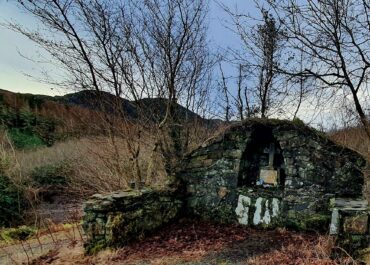Ecclesiastical enclosure, Reachlainn Uí Bhirn, Co. Donegal
On the remote Rathlin O'Birne Island off the coast of Donegal lies a fascinating multi-period ecclesiastical site that reveals centuries of religious activity.
Ecclesiastical enclosure, Reachlainn Uí Bhirn, Co. Donegal
The polygonal enclosure, measuring roughly 40 metres square, shows at least three distinct phases of construction. What likely began as a small sacred space surrounding an oratory and two stone houses in the southeast corner gradually expanded northward with a trapezoidal addition, before finally incorporating a western knoll into the complex. The enclosure walls, now mostly reduced to footings of rubble and shingle with occasional large facing stones, were never particularly substantial structures, suggesting a community more concerned with spiritual boundaries than defensive ones.
The inner enclosure sits cleverly positioned on a slight natural rise within a shallow depression, with the ground falling away to the east and the main entrance at the southwest. A cross-wall divides the space into upper and lower terraces, incorporating a leacht (a small stone cairn or monument) topped with a cross-inscribed slab. Within this sacred boundary, archaeologists have identified an impressive collection of structures and artefacts: a holy well housed in a flag-roofed structure at the northeast corner, two stone cells, an oratory, what’s probably a church, a possible kiln, foundations of two rectangular buildings, and nine cross-inscribed slabs. Numerous flat and upright slabs scattered throughout likely mark ancient graves, painting a picture of a site that served as both a living monastic community and a burial ground.
The holy well, still accessible through its original well-house open to the northeast, sits alongside a second well near the enclosure’s northeastern corner, with a gap between them possibly serving as a secondary entrance leading down to the shore 60 metres away. Beyond the inner enclosure, traces of an outer crescentic enclosure can still be seen, connected by two walls to the main complex. Field walls from later agricultural use abut the ruins on the northwest, including one with an interior fosse (ditch) that still drains the marshy ground to the southwest; a practical reminder that even after the monks departed, the island’s inhabitants continued to work with and around these ancient sacred boundaries.


